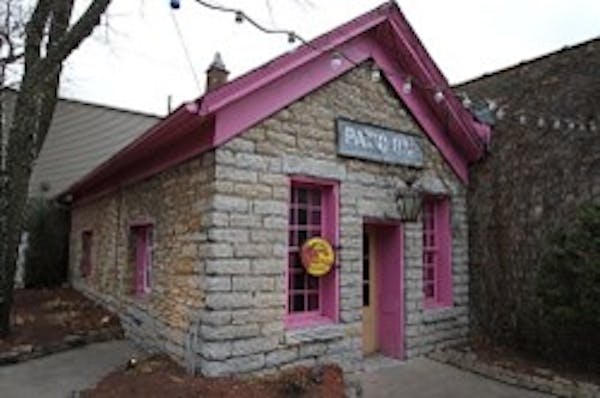St. Paul's Heritage Preservation Commission on Monday voted to deny demolition of the historic Justus Ramsey House, the tiny limestone house on the patio of Burger Moe's restaurant that is one of the city's oldest structures.
Burger Moe's owner, Mojtaba Sharifkhani, requested a demolition permit after a wall of the cottage collapsed earlier this year. Sharifkhani had argued, and city inspectors agreed, that the building's current condition is unsafe.
But, citing the building's historic significance — the cottage is on several historic registers — and other recommendations that the building can be shored up and later repaired, the panel voted 8-1 to deny a demolition permit. The commission was unmoved by Sharifkhani's impassioned pleas that the house is unsafe "for my staff, for the public, for myself."
"You are literally liable, if wall falls down and someone gets killed there," he said, at times shouting. "Please. You do the right thing."
But several neighbors said they suspect much of the damage done to the interior of the building was intentional and not caused by water leaking, as Sharifkhani said. Tom Schroeder, a neighbor, preservationist and owner of the historic Waldmann Brewery nearby, said funds are available and expertise has been offered to help Sharifkhani shore up and stabilize the building.
But the owner of Moe's would rather tear it down, Schroeder and others said.
"If the owner is truly concerned about public safety, he should fix the building, using his own contractor," Schroeder said.
Several neighbors said Sharifkhani has refused to meet with them to talk about what options are available short of demolition. The owner of Burger Moe's, who also owns the Downtowner across the street on W. 7th, has refused several interview requests and did not immediately return a call seeking comment Monday.
The Justus Ramsey House, built in 1852, is the oldest surviving limestone house from St. Paul's pioneer era and it's listed on three historic registers — including the National Register of Historic Places. The small house was built for Justus C. Ramsey, brother of Alexander Ramsey, who owned the property jointly with Alexander and others from 1849 to 1852. The first known resident was Robert A. Smith in 1853. Smith would later become St. Paul's longest-serving mayor.
For about 40 years, from the 1890s to 1933, the 170-year-old limestone cottage was home to railroad porters and hairstylists, shopkeepers and domestic servants and was the center of Black life in St. Paul before the ascent of the Rondo neighborhood.
Dave Thune, a resident of the area and its former City Council member, said Sharifkhani has long complained about the cottage and wants to get rid of it. Because the Justus Ramsey House is a local Heritage Preservation site, demolition permits must go to the Heritage Preservation Commission for review and approval.
Sharifkhani can appeal the commission's action to the St. Paul City Council.
One of five surviving pioneer stone houses in St. Paul — a list that includes Waldmann — the Justus Ramsey House has been extensively reviewed and inspected over the years, Schroeder said. As recently as 2015, it was in "perfect condition." Now, there is a hole in the roof, the interior has been damaged, and part of an exterior stone wall has collapsed.
Neighbors have suggested moving it to other sites, including several vacant lots in the area or to open space near Keg & Case Market, on the grounds of the former Schmidt Brewery.
While many in the neighborhood continue to press for preservation, either in place or at some other site, Schroeder said that with winter coming, accumulated snowfalls might accomplish what Sharifkhani has been trying to do.
"It's been set up to be at risk of collapse," Schroeder said. "We're greatly concerned about that. I mean, if I could get in the building with a 4-by-4, I'd [shore it up]. Basically, that's what we need to get it through the winter."
He added: "And all this talk of safety? Moe has taken multiple parties through that building on tours to convince them that it should be torn down, but he doesn't feel safe going in there with a qualified contractor to do anything about keeping it up."
Staff writer Katie Galioto contributed to this article.
New director of Minneapolis Animal Care and Control is longtime abuse investigator Tony Schendel
Brooklyn Park police make arrest after asking for help in search for man suspected of sexual assault at gunpoint

Attorney Tayler Rahm wins GOP backing in battleground Second District
North Oaks withdraws request for density exemption from Met Council

